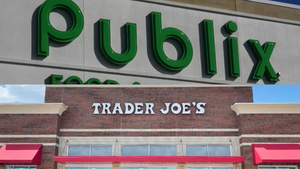How to make the make the meat department a shopper destinationHow to make the make the meat department a shopper destination
Responding to consumer preferences can create allegiance and allure
September 17, 2024

Meat activity is on the upswing, and that is creating strong revenue opportunities for retailers that can forge shopper loyalty and stand out in a dynamic environment.
Fresh meat sales reached $70 billion for the 52 weeks ending June 30, with pound sales up 1.3% versus the year-earlier period, reports Circana, a Chicago-based market research firm. To cash in on the vibrant market, it is essential that retailers make their meat departments shopper destinations by meeting the demands of their key customer segments while differentiating offerings from those of competitors, analysts said.
That includes, most importantly, the frequent meat purchaser. About 30% of shoppers account for approximately 66% of fresh meat sales, with the top 10% spending about four times as much as the average meat consumer and visiting stores more often, said Anne-Marie Roerink, president of 210 Analytics LLC, a San Antonio-based market research and marketing strategies firm and author of the Power of Meat 2024 report, published by Arlington, Va.-based FMI—The Food Industry Association, and the Washington, D.C.-based Foundation for Meat & Poultry Research & Education.
To maximize activity, retailers must respond to shoppers’ value perception, she said, which goes beyond cost. “Competitive prices are important, but price goes hand-in-hand with quality and department cleanliness,” Roerink said. “Retailers have to win on all the operational fundamentals.”
Having full-service counters and butchers that can give purchasing and preparation advice is vital as well, she said, noting that those elements are a main reason many consumers, and especially older customers, pick one store over another.
Ensuring availability of a wide range of cuts is important too, Roerink said. “An out-of-stock can negatively impact sales far more than just having one lost purchase,” she said. “At best, the consumer buys something else. At worst, they abandon the trip, go elsewhere, and you lose the entire cart.”
Cost can be costly
Having a strong image for merchandising high quality and affordable meats also is essential as shopper anxiety about price is resulting in purchasing changes, said Melissa Myres, director, insights, for 84.51°, a Cincinnati-based research and insights firm and a unit of The Kroger Co.
Sixty-six percent of shoppers, for instance, claim that they are extremely concerned about inflation, the highest amount since March 2023, 84.51° research found, with 64% indicating that they are looking for sales, deals, or coupons more often, and 22% stating that they are buying fewer selections of meat, fish, and produce.
In addition, 79% of shoppers claim that they notice price increases in the meat, deli, and fish counters, and 37% note that they would switch to a cheaper cut of meat. Before trading down, however, shoppers are more likely to seek sales or deals (noted by 66% of consumers) or stock up when their preferred item is on sale (61%).
“Knowing that consumers are looking to stretch their dollars, retailers can ensure that the promo strategies make sense,” Myres said.
The most effective operators will also focus on shopping experience, product relevance, and convenience, said Rick Stein, FMI vice president of fresh foods. Relevance can include offering package sizes that appeal to specific shopper groups, such as single households, and retailers might enhance the experience by situating videos in the meat department that provide cooking instructions for specific cuts, he said.
“The two leading fresh departments, meat and produce, play a huge role in where consumers shop,” Stein said. “The majority of customers will pick a retailer based on its reputation for both.”
By offering a wide range of proteins and cuts, retailers can meet the expectations of shoppers who continue to cook more at home following the pandemic and want to experiment with new selections, he said. “That is how a retailer makes itself a shopper destination,” Stein said.
Nevertheless, merchandisers should not try to be “all things for everyone,” he said. “By doing so, retailers end up not doing any specific thing well. Understand who the customer is that you are trying to serve and do that well by not spreading yourself thin.”
Cater to the consumer
Modesto, Calif.-based The Save Mart Companies is among the retailers seeking greater shopper satisfaction by offering products that its customers most request along with unique offerings, such as Wagyu beef, said Bill Arnold, vice president of meat and seafood. “Ultimately, that is what’s going to result in return visits,” he said.
With costs and shrink the biggest merchandising concerns, The Save Mart Companies, which operates approximately two hundred Save Mart, Lucky, and FoodMaxx stores throughout California and Western Nevada, is limiting the amounts of product in its fresh meat cases “for a more controlled approach to selling,” Arnold said. “We will evaluate the financials of select items and utilize the data to determine display size from a procurement, allocation, and sales perspective.”
To simplify shopping, the retailer categorizes its meat offerings in accordance with outlets’ specific customer bases and the shoppers’ “needs, wants, and overall expectations,” he said. Stores may situate meats by product benefit, such as being organic, vegetarian fed, free range, and grass fed, and cooking methods, including oven, roasting, pan frying, sauté, grilling, and broiling.
Locations also can have a ground meat section containing fresh grinds, patties, sausage, and meatballs, along with a value area. “The is no one size fits all approach,” Arnold said.
It is important for retailers to analyze the consumers in their geographic areas and determine the pricing and products necessary to attract them, Stein agreed. “That is an art form and those that do it best are the most successful,” he said.
Retailers, however, should still take a long-term approach when developing merchandising strategies, Stein said. That might include a willingness to generate shrink by discarding discolored items despite the proteins being safe to eat, he said.
“The unintended consequence is that the customer thinks the meat is bad, and, in turn, they don’t trust the entire department and sales go down,” Stein said.
About the Author
You May Also Like






